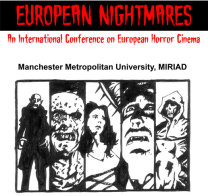Russell Hunter
University of Wales, Aberystwyth
Now They Are Everywhere! Ecology, Contamination and Italian Horror

 Windows Media Video
Windows Media Video
[Download Windows Media Player]
Ecological concerns take up an increasingly important place in film studies. In Ecomedia, Sean Cubitt analyses a score of films (including Spirited Away and Koyaanisqatsi) in relation to how their narratives and styles use environmental concerns to develop themes of spirit-earth, naturalism, and contamination. But Cubitt ignores the important contribution horror films have in this respect, from zombie films like Dawn of the Dead (Romero, 1978) to contagion film like 28 Days Later (Boyle, 2002).
This paper analyses a small but fascinating group of Italian horror films that seem to approach environmental concerns from a different angle, offering a less metaphoric and more literal ecological position. They are: The Living Dead at Manchester Morgue (Jorge Grau, 1974), Zombie Flesh Eaters (Lucio Fulci, 1979), Nightmare City (Umberto Lenzi, 1980) and Zombie Holocaust (Marino Girolami, 1980). Building upon two recognised horror tropes of the dichotomy of countryside-city, and the science-gone-wrong subject that is so central to the body-horror subgenre, these films, released between 1974 and 1980, put ecology at the heart of their narrative development. Crucially the stress is upon the ways in which failing to adhere to an environmental ‘precautionary principal’ is likely to have unpredictable and dire environmental consequences.
But when compared to how ecological concerns were debated in the public sphere of the time there is a curious difference: the films inherent conservative-green politics placed them firmly against what Andrew Dobson has called drawing-board design environmentalism, suggesting an underlying suspicion of unguarded scientific development and environmental interventionism. The reason for this difference lies in the films unwillingness to engage in progressive possibilities for the relationship between scientific/technological development and ecological concerns.
This difference is something that is hardly (or not very widely) echoed in the reception of the films. It thus points to how the development of ecological concerns in horror films is not restricted to the American zombie films of the time, or to more recent films. Rather, growing opportunities for public discourse around environmental concerns now offers new possibilities for exploring the green political themes immersed within their narratives.
Sample bibliography
Cubitt, Sean (2005), Ecomedia, Amsterdam: Rodopi
Dobson, Andrew (1995), Green Political Thought, 2nd Edition, London: Routledge
Hochman, Jhan (1998), Green Cultural Studies: Nature in Film, Novel and Theory, Idaho: University of Idaho Press
Palmerini, Luca & Gaetano Mistrano, (1996), Spaghetti Nightmares: Italian Fantasy-Horrors as Seen Through the Eyes of Their Protagonists, New York: Fantasma Books
Paul, Louis (2005), Italian Horror Film Directors, London: McFarland
Tudor, Andrew (1989), Monsters and Mad Scientists: A Cultural History of the Horror Movie, Oxford: Blackwell
Slater, Jay (2002), Eaten Alive: Italian Cannibal and Zombie Movies, London: Plexus

